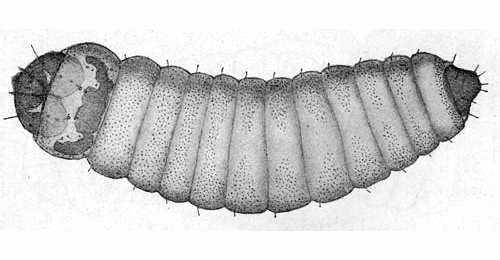|
||||||
|
Cedestis
gysseleniella Zeller, 1839 Gold Pine Ermel Cedestis gysseleniella Zeller, 1839. |
||||||||||||||||||||||||||||||||||||||||||||||||||||||||||||||
|
Leaf-miner: A relatively large, ribbed, oval egg is deposited near the base of the needle, on the outer, convex, side. The emerging larva at first makes a wavy, epidermal, corridor, running in the direction of the needle tip. Soon the gallery becomes deeper and fills the entire needle. The larva works itself to close to the tip of the needle; the mine behind it is almost completely filled with frass. Pupation external; the exit opening is just under the tip, in the flat side of the needle Bladmineerders van Europa. The larva feeds internally in a needle, working its way from the base to the tip. It may then feed externally in a slight web (UKMoths). Larva: The larvae of moths have a head capsule and chewing mouthparts with opposable mandibles (see video of a gracillarid larva feeding), six thoracic legs and abdominal legs (see examples). During the mining phase the larva is orange red, but on emergence is shiny green (British leafminers). The larva is illustrated in Bladmineerders van Europa.
Pupa: The pupae of moths have visible head appendages, wings and legs which lie in sheaths (see examples). Pupation in a white cocoon on the ground. The pupa is initially green, then darkens as it matures (British leafminers). The pupa is illustrated in Bladmineerders van Europa. Adult: The adult is illustrated in UKMoths and the Encyclopedia of Life. The species is included in mothdissection.co.uk. Hosts in Great Britain and Ireland:
Hosts elsewhere:
Time of year - larvae: March - April (British leafminers). Time of year - adults: The adults fly in June and July, when they can be attracted to light (UKMoths). Distribution in Great Britain and Ireland: A widespread but local species occurring over much of England and Scotland in its favoured habitat, pine woodland (UKMoths), including Bedfordshire, Dorset, Durham, East Ross, East Sutherland, Easterness, Elgin, Hertfordshire, Kincardineshire, Linlithgow, Middlesex, North Hampshire, North Somerset, North Northumberland, Nottinghamshire, Shropshire, South Aberdeenshire, South Northumberland, Stafford, Stirlingshire, Surrey, West Lancashire, West Norfolk, West Perthshire, West Suffolk and Westmorland (NBN Atlas). Distribution elsewhere: Widespread in continental Europe including Austria, Belarus, Belgium, Bulgaria, Czech Republic, Danish mainland, Estonia, Finland, Germany, Greek mainland, Hungary, Italian mainland, Latvia, Lithuania, Luxembourg, Norwegian mainland, Poland, Romania, Russia - Central, North and Northwest, Slovakia, Spanish mainland, Sweden, Switzerland, The Netherlands and Ukraine (Fauna Europaea). NBN Atlas links to known host species:
British and Irish Parasitoids in Britain and elsewhere: Currently unknown. |
||||||||||||||||||||||||||||||||||||||||||||||||||||||||||||||
| Last updated 25-Jun-2019 Brian Pitkin | ||

